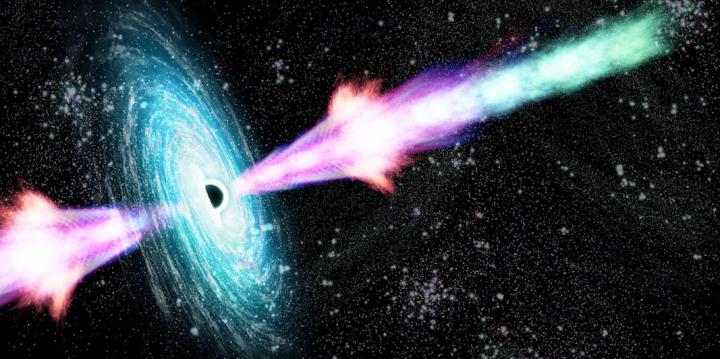Groundbreaking research from Bath suggests the brightest source of energy in the universe is powered by the collapse of a dying star’s magnetic field.

Credit: Nuria Jordana-Mitjans
When a massive star in a distant galaxy collapses, forming a black hole, two giant jets of light-emitting plasma shoot from its core. These extremely bright gamma-ray bursts (GRBs) are the most powerful explosions in the universe, and when a jet points towards Earth, the afterglow can be detected from ground and space-borne telescopes. Material does not simply catapult from an exploding star, it accelerates to ultra-high speeds along the narrow beam of the gamma-ray jet, leaving astrophysics puzzled over the power source driving these extraordinary explosions. Now a new international study led by the University of Bath promises to shed light on this mysterious phenomenon.
Many astronomers favour an explanation for GRBs based on the baryonic jet model. This states that repeated violent collisions between material blasted out during the explosion and material surrounding the dying star produce the gamma-ray flash and the subsequent fading afterglow – the dying embers of the expanding fireball.
A second hypothesis, called the magnetic model, posits that a huge, primordial magnetic field in the star collapses within seconds of the initial explosion, releasing energy to power the prodigious blast.
Now, for the first time, an international team of researchers has found evidence backing this magnetic model. Working in collaboration with researchers from the UK, Italy, Slovenia, Russia, South Africa and Spain, Bath astrophysicists examined data from the collapse of a massive star in a galaxy 4.5 billion light-years away. They were alerted to the star’s collapse after its gamma-ray flash (named GRB 190114C) was detected by NASA’s space-borne Neil Gehrels Swift Observatory.
The researchers noted a startlingly low level of polarisation in the gamma-ray burst in the moments straight after the star’s collapse, indicating the star’s magnetic field had been destroyed during the explosion.
Nuria Jordana-Mitjans, lead author of the Astrophysical Journal paper, and holder of the Hiroko and Jim Sherwin Postgraduate Scholarship in Astrophysics, said: “From previous studies, we expected to detect polarisation as high as 30% during the first hundred seconds after the explosion. So we were surprised to measure just 7.7% less than a minute after the burst, followed by a sudden drop to 2% soon after.”
She added: “This tells us that the magnetic fields collapsed catastrophically straight after the explosion, releasing their energy and powering the bright light detected across the electromagnetic spectrum.”
GRBs are detected by dedicated satellites orbiting Earth, however no one can predict where or when a GRB will appear, so scientists rely on autonomous rapid-response robotic telescopes to catch the fast-fading light of the afterglow. Seconds after the NASA observatory identified GRB 190114C, robotic telescopes located in the Canary Islands and South Africa received NASA’s discovery notification and repointed. Within one minute of the GRB discovery, the telescopes were gathering data about the emissions.
Professor Carole Mundell, head of Astrophysics at the University of Bath and co-author on the research, said: “Our innovative telescope systems are entirely autonomous, with no humans in the loop, so they slued very quickly and began taking observations of the GRB almost immediately after its discovery by the Swift satellite.”
Prof Mundell continued: “It is remarkable that from the comfort of our own homes, we were able to discover the importance of primordial magnetic fields in powering a cosmic explosion in a distant galaxy.”
###
This GRB study was run by the University of Bath in collaboration with scientists at Liverpool John Moore University UK, the University of Ferrara Italy, the University of Nova Gorica Slovenia, the South African Astronomical Observatory, the Instituto de Astrofisica de Canarias, Spain, Lomonosov Moscow State University and Irkutsk State University Russia.
For further information, or to arrange interviews with Professor Carole Mundell or Nuria Jordana-Mitjans, please contact the University of Bath Press Office on 01225 386319 or email [email protected]
University of Bath
The University of Bath is one of the UK’s leading universities both in terms of research and our reputation for excellence in teaching, learning and graduate prospects.
The University is rated Gold in the Teaching Excellence Framework (TEF), the Government’s assessment of teaching quality in universities, meaning its teaching is of the highest quality in the UK.
In the Research Excellence Framework (REF) 2014 research assessment 87 per cent of our research was defined as ‘world-leading’ or ‘internationally excellent’. From developing fuel efficient cars of the future, to identifying infectious diseases more quickly, or working to improve the lives of female farmers in West Africa, research from Bath is making a difference around the world. Find out more: http://www.
Well established as a nurturing environment for enterprising minds, Bath is ranked highly in all national league tables. We are ranked 5th in the UK by The Guardian University Guide 2018 and 6th for graduate employment. According to the Times Higher Education Student Experience Survey 2017, we are in the top 5 universities students would recommend to a friend. Bath has also been named Sports University of the Year 2018 by The Times and Sunday Times.
Media Contact
Vittoria D’Alessio
[email protected]
Original Source
http://www.
Related Journal Article
http://dx.




